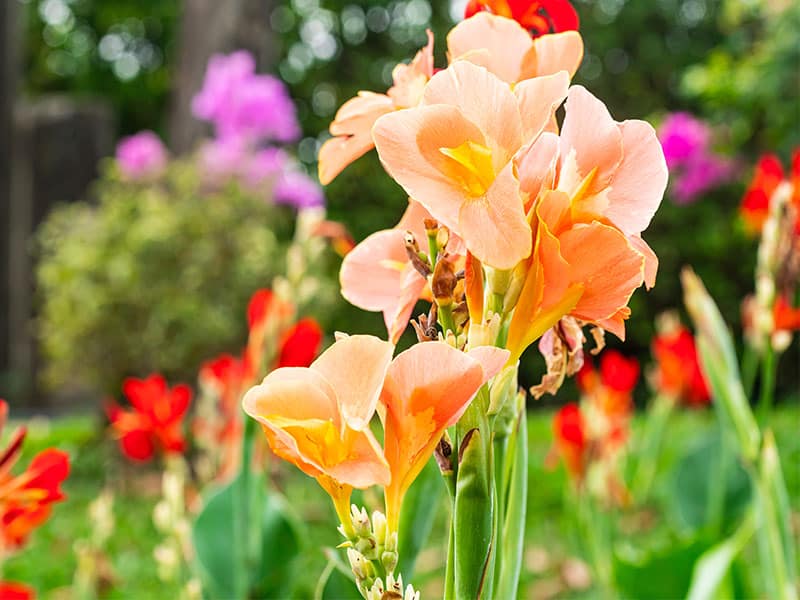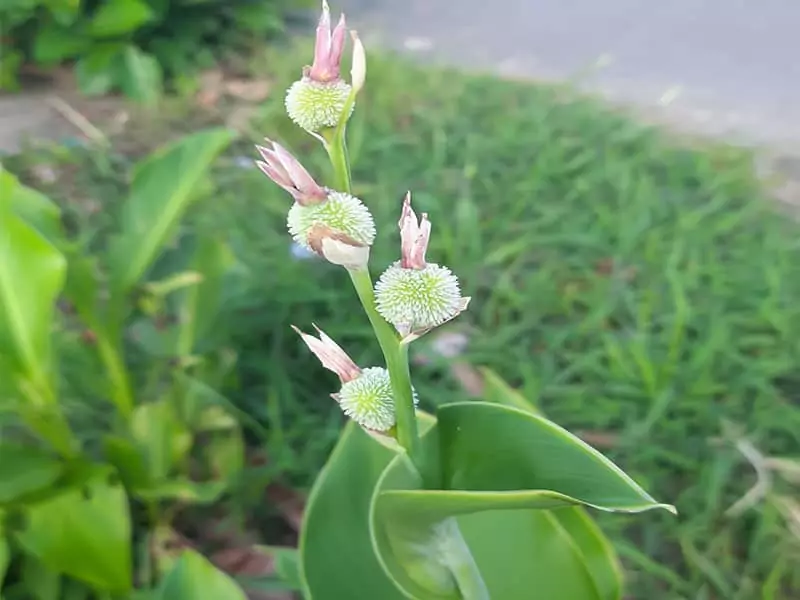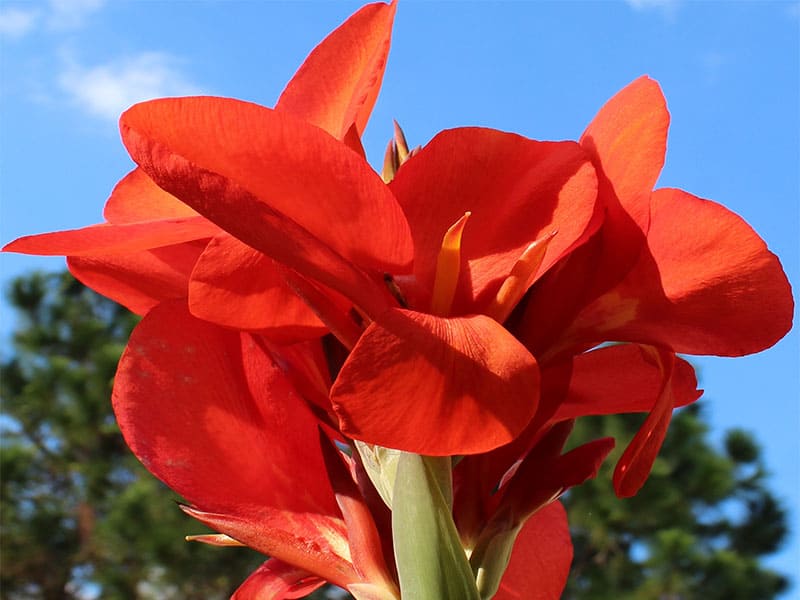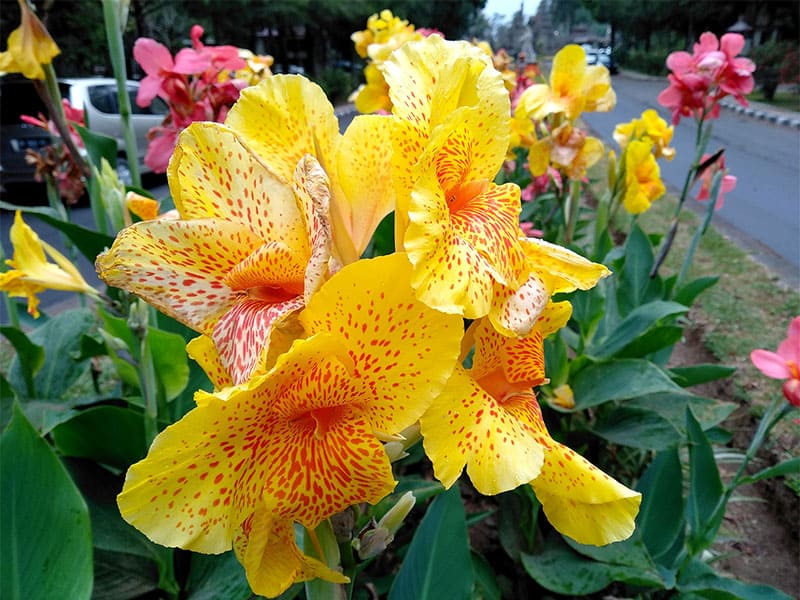How to Plant Canna Lilies
Wondering how to plant canna lilies? Good news: even if you are a complete beginner in the gardening world, canna lilies are a superb choice because they are easy to plant and grow.
Canna lilies are low-maintenance but rewarding garden plants. With their tropical appearance, vivid flowers, and foliage, canna lilies ennoble every garden.
Don’t shy away from introducing them to your garden. Canna lilies are hardy in zones of 8-11, but you can find them anywhere across the country. Luckily, there is a way to grow them in cooler climates.
Here is everything you need to know to successfully plant and grow canna lilies in your garden.
Quick Answers: How to Plant Canna Lilies?
Planting and caring for canna lilies is simple if you know your timing, location, and how to work with rhizomes. Here is a quick guide, but keep reading for more detailed information and useful tips.
- Start in mid-spring or early summer
- Choose a sunny location and well-draining soil
- Plant whole rhizomes in 3-inch deep holes
- Water thoroughly
- Apply fertilizer once a month
- Deadhead stems after you notice spent flowers
- Dig the plants in autumn if you live outside zones 8 and 9 and store them over the winter
- Transplant them in spring
- Propagate by division every three or five years

What Are Canna Lilies?
Canna lilies are rhizomatous perennials. The plant belongs to the family of Cannaceae, with the botanical name Canna x generalis.Canna lilies are the only genius in this family which has about 19 species – ten wild species, and nine additional ones. The categorization has been completed by two taxonomists, hence, there are differences in the number of species.
Essentially, canna lilies are tropical plants, but plenty of cultivars have been adjusted to mild climates. They need around six to eight hours of direct sun exposure to thrive.
The plants have large and vivid foliage and red, yellow or flowers that resemble iris flowers. It retains the vivid color of leaves and flowers for a long time. Interestingly, canna lilies can grow up to 10 feet in height. But, there are dwarf varieties that can be grown in containers.
Watch this video to know more:
Canna Lilies Species
Canna flowers are popular worldwide for ornamental use. Therefore, some experts argue that there are between 50 and 100 hybrids available around the world. But, some of them are duplicates and don’t require a specific name.
Here is a short overview of ten wild species:
- Canna bangii: large green leaves with erect flowers in orange and red
- Canna flaccida – yellow flowers with a distinctive scent
- Canna glauca – suitable for wet soil, very popular specie
- Canna indica – early-blooming specie, purple arrowroot, known by the name Indian shot
- Canna iridiflora – resistant to cold, huge flowers, self-cleaning flowers
- Canna jaegeriana – thrives in warm areas, round and fuzzy flowers
- Canna liliiflora – challenging to grow, strong scent, gentle, off-white flowers
- Canna paniculata – frost tender, delicate orange-red flowers
- Canna pedunculata – glaucous and narrow leaves, yellow, small flowers with nine petals
- Canna tuerckheimii – large specie, red-orange erect flowers

How to Plant Canna Lilies – Detailed Guide
When I first started growing canna lilies in my garden, there weren’t as many useful tips online. The plant is easy to grow and doesn’t require any special skills. The maintenance is simple, once you learn when, where, and how to plant it. Here is everything to know.
Watch this video to know more:
When to Plant Canna Lilies?
The ideal time for planting cannas is from mid-spring to early summer. If you live in a colder climate, wait until early summer. In general, the highest chances for successful planting are when the soil temperature is at least 60 degrees Fahrenheit.
There are two ways to determine the soil temperature. You can either check online, as some state extension websites include this information.
You can also use my method, but you will need an old-school mercury thermometer.
Dig a tiny hole in the soil, approximately two inches deep, and put the thermometer inside. Wait for a couple of minutes, and the thermometer will show you the current soil temperature.

Where to Plant Canna Lilies?
To help you determine the ideal place for cannas in your garden, I must first explain how much sun canna lilies need. Additionally, you need to consider their height and placement around other flowers.
Cannas are tropical plants, so a lot of sunshine is appreciated. The flowers thrive in moist and fertile soil. Even though full sun exposure is a perfect location for cannas, most species can survive in partial shade. If your plants don’t get enough sun, the flowers won’t be large and vivid. Instead, you can expect smaller blooms and faded color of foliage.
Observe your garden during the day, and find the location that gets a minimum of four hours of sun per day. Morning and afternoon sun exposure are ideal because direct exposure to the sun during the hottest parts of the day can cause flowers to fade slightly.
Cannas do well in the majority of soil types, but the best pH value of the soil for these plants is around 6.5. Make sure that the soil is well-drained and water-retentive to avoid diseases.
You can improve the soil quality just before planting by loosening it up at a 12-inch depth.
Add a 2-inch layer of compost for the best results.
Most cannas are tall, so you should plant them at the back of the flower bed. If you purchase dwarf varieties, you can place them at the front, too.
Cannas look good with other spring bulbs and on the borders of your garden.
How to Plant Canna Lilies?
You can plant cannas from seeds or rhizomes. Planting rhizomes is an easier method for beginners, but experienced gardeners might enjoy planting Cannas from seeds. I will cover both methods.
Planting Canna Lilies From Rhizomes
Even though most people think about Cannas as bulbs, they aren’t true bulbs. They have rhizomes – fattened stalk extensions underneath the soil.
In my experience, soaking the rhizomes can be beneficial but not required for first-time planting. If you are replanting Cannas after winter, you can soak them for 12 hours in compost tea mixed with water and fish emulsion before planting. It will help the rhizomes to break dormancy much faster.
Also, if you aren’t sure about the proper rhizome placement, you don’t have to worry. The new growth develops toward the sun and fixes the improper placement.
Here is a step-by-step process.
- Start by digging holes for each rhizome you’ve got. The hole should be around 3-inch deep.
- Place the rhizome in the hole, with eyes facing upwards.
- Add a 2-inch thick layer of soil over the rhizomes and tamp the soil firmly.
- Water freshly planted rhizomes.
- Dig as many holes as you have rhizomes, but space them from 1 to 4 feet apart.
Planting Canna Lilies From Seed
Planting beautiful Cannas from seed is a bit more complex than transplanting rhizomes. However, keep in mind that most canna lilies nowadays are hybrids, so propagating by seed won’t give you exact duplicates of the flowers. Some variations in flower color may happen.
You can buy seeds in nurseries, or harvest them from plants. You can expect the first flowers to appear approximately six months after planting the seeds. If you’ve chosen a sunny location, you will notice flowers even earlier.
- When the flowers finish their blooming season, check for round seed pods. Each one has from one to three seeds.
- Wait until the pod is dry to harvest the seeds.
- Open the pod, and squeeze it to get large black seeds.
- Mix water with a teaspoon of hydrogen peroxide to improve seed germinationand soak the seeds overnight before planting.
- Plant seeds in airy, moist soil in plastic containers indoors in winter.
- Keep the containers in a light place and the soil moist but not soggy.
- Watch for shots in containers by the time the temperature rises and the frost passes.
- Transplant the plants into pots or sunny locations in your garden.

Watch this video to know more:
How to Care for Canna Lilies?
Canna lilies are very easy to care for most of the year. You can expect full-color foliage to develop on warmer days, with a minimum temperature of 60 degrees Fahrenheit.
Cannas love water, especially during long summer days. So, ensure that they get enough water, especially during the dry spell. Water them thoroughly two times per week once you notice that the soil is completely dry.
Fertilizer
When it comes to fertilization, gardeners have opposite opinions. While some gardeners advise the heavy application of fertilizer, others are unconcerned about it.
In my experience, fertilizer is useful, but not essential. My cannas bloomed the entire summer with occasional application of fertilizer.
You can use a 5-10-5 fertilizer once in the spring and once a month during the blooming season. Additionally, a 10-10-10 fertilizer will do just fine as well.
Fish emulsion fertilizer is a great organic alternative, rich in nitrogen.
Once you apply fertilizer, retain a thin mulch layer, it will help the soil stay moist and boost the effects of fertilization.
Deadheading Cannas
Deadheading flowers ensure re-blooming and can help next year’s blooms to be even prettier.
Deadheading canna lilies is quite easy. All you have to do is cut off old flower stalks just above the flowering node. Inspect the plant for spent flowers during every watering session in summer to induce new blooms.
You can do it with pruning scissors or with your hands and toss the spent flowers.
Each stem will produce a few flowers, and once the flowering is done, you should cut the stem and all attached leaves. Cutting the leaves will ensure that the rest of the plant is getting more sun.
If you don’t want to cut foliage, you can only prune the stem to the leaves, but it will only last until the frost.
Caring for Cannas in Autumn and Winter
Cannas can survive outside during autumn and winter only in USDA hardiness zones 9 and 10. Everywhere else, they need to be kept indoors to survive frosts and cold winter months.
To prepare your plants for the next season, start by cutting your plants to 4-inches. Do it when the temperatures drop, from mid to late autumn.
If you live in the deep U.S. South, wait until the first frost passes to dig the rhizomes and keep them inside. In zones six and colder, dig the plants before the frost and keep them inside.
You can dig the roots with a small shovel. Start digging at a one-foot distance from the stem to avoid damaging the rhizome. Use your hands to loosen the soil and remove rhizomes gently from the ground. Shake the excess dirt and divide clumps with a maximum of five eyes on each bulb.
You can use paper bags with peat moss to keep the bulbs dry and prevent them from rotting.
Keep them in the attic or basement, but make sure that the temperature doesn’t go below 40 degrees Fahrenheit. Sprinkle them with sand occasionally during the winter to prevent them from drying. Inspect the bulbs a few times during the winter, and cut rotten parts.
Be prepared that some clumps will die whatever conditions you ensure.
Wait until spring to bring back your canna lilies outdoors.
Watch this video to know more:
How and When to Propagate Canna Lilies?
Canna lilies develop quickly but can benefit from propagation every three or five years. You can propagate them in spring or fall by division.
Once you dig up the whole plant, separate the rhizomes and cut along joints. New rhizomes should have at least one eye.
Plant them back in the ground if it is spring, or wait for the winter to pass if you are propagating canna lilies in autumn.

Watch this video to know more:
Canna Lilies Pests and Diseases
Cannas are generally resilient plants, and you shouldn’t expect many issues with pests and diseases.
Holes in the foliage are signs that beetles and snails might chew the leaves. To prevent them, you should remove weed around cannas and other plants frequently and remove any debris, so snails won’t have a place to hide.
Caterpillar called a leaf roller is maybe the worst thing that can happen to your canna lilies. It lays the eggs in the stalk and leaves a sticky web on the foliage. If you notice a sticky texture on the leaves, remove them immediately and use mild insecticide on the rest of the plant.
Other issues are rust fungus and mosaic virus, rarely aster yellows disease. The symptoms appear as sick and yellowish foliage.
Remove the infected leaves and wait for the plant to get better. If you don’t notice improvement after a week or two, dig up the whole plant and toss it away. It means that your plant suffers from aster yellow.
Canna Lilies – A Dash of Tropical Paradise in Your Garden
Tropical plants are hard to grow outside tropical zones. Luckily, it doesn’t apply to canna lilies. The plant is perennial in zones 8 and 9, but you can easily keep it alive in other zones by storing it inside over the winter.
It is one of the easiest tropical flowers to plant, grow and care for. I recommend you to start them in your garden from rhizomes and leave the seed method for propagating experts!
Planting them from rhizomes is a fool-proof method that will ensure successful growth. Just make sure your flowers are getting enough sun and water, and enjoy your lovely tropical flowers!
If you find my guide useful, please like it and share it with your friends and family. Please let me know how your canna lilies are doing? What was the biggest challenge you faced in your garden?

